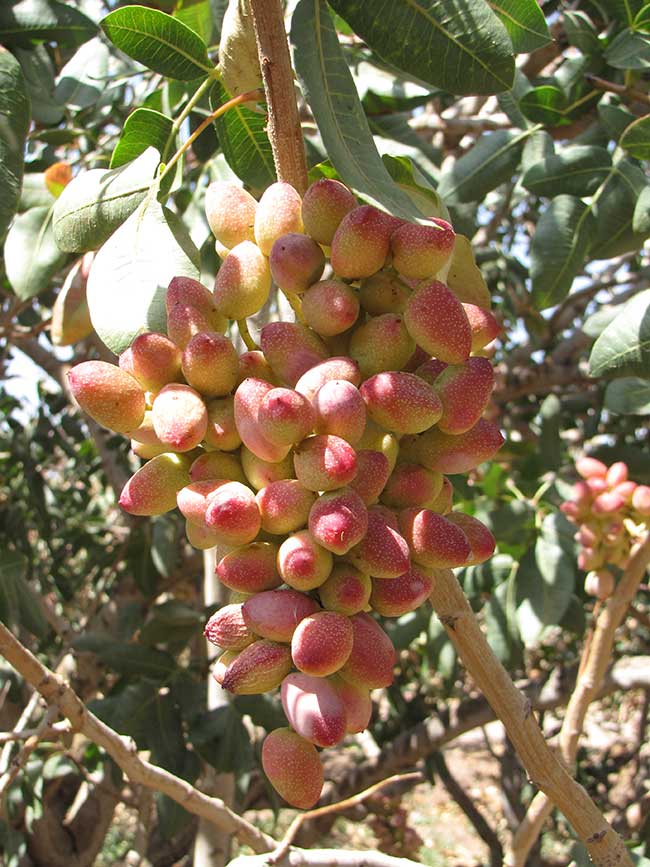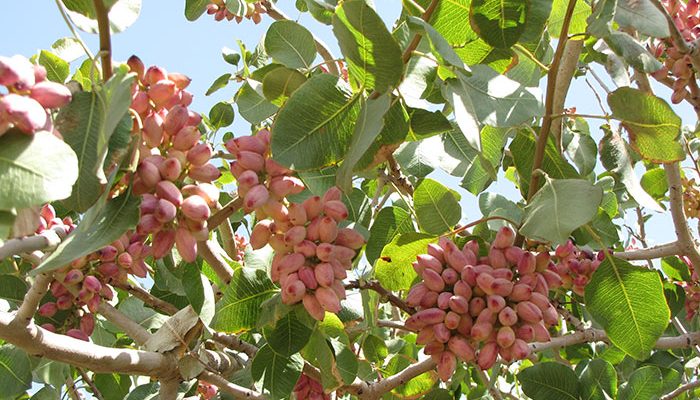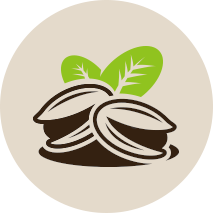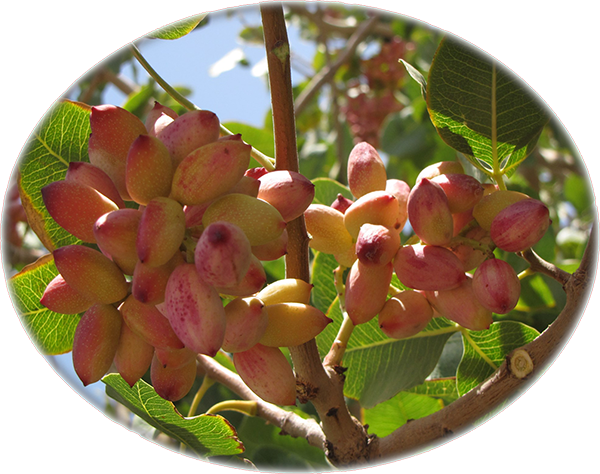About Iran Pistachio

All you need to know about Iran pistachio.
History

The modern pistachio nut was first selected from wild Pistacia vera trees native to central Asia. The initial selection and improvement was first undertaken in the era of the Persian Empire which spanned from the Eastern Mediterranean to central Asia. Ever since, pistachios have been an important crop in cooler parts of the Iranian plateau.
Pistachio cultivation spread into the Mediterranean world where it has continuously prospered in Syria, Turkey, Greece and Sicily. Pistachios were already well known in Late Antiquity. Since 1970s, pistachios have become a commercial crop in many countries which fall around the 30th parallel north and south of the equator. These regions include: California, North Africa, New South Wales in Australia, South Africa, Argentina and Chile.
Since 1970s, pistachios have developed from a luxury nut appreciated only by the rich into a supermarket item enjoyed by all.

Botany

The pistachio of commerce is the only edible species among the 11 species in the genus Pistacia; all are characterized by their ability to exude turpentine or mastic. Several are referred to as pistachios, but the name is generally reserved for the edible nut of commerce. Its Latin name is Pistacia vera L. A member of the family Anacardiaceae, it is related to the cashew, mango, poison ivy and oak, pepper tree and sumac.
The Pistachio is a relatively small tree mostly grown in the arid parts of the world close to 30th parallel latitude. It grows from sea level (e.g. Attica, Greece) to an altitude of 1800 meter above sea level (e.g. Kerman, Iran). The combination of latitude and altitude should provide enough chilling hours in winter and long hot and sunny summer conditions to produce a viable crop.
Pistachios bear laterally on one-year-old wood. This causes an alternate bearing habit, very prominent in pistachio production with extensive commercial consequences.
Pistachio tree is deciduous, i.e. it loses its leaves in the fall and remains dormant through the winter. The tree is dioecious (i.e. two houses), meaning the male flowers are borne on one tree and the female flowers on another. Therefore, both male and female trees are needed for nut production. The pollen is spread by wind.
The trees have extensive root systems allowing them to mine the soil deeply. Thus, pistachios are adapted to survive long periods of drought. They need a well-drained soil. In such soils, the tree can tolerate relatively high levels of salinity in soil and/or irrigation water.
Pistachios are characterized by a long juvenile period, typically bearing few nuts before six years of age. They achieve full bearing between 15 to 20 years of age.
Nut Morphology and Maturation

The individual pistachio nut grows in fruit clusters of multiple nuts, much like grapes. Botanically, they are drupes, the same classification for almonds, peaches, apricots, cherries and plums. All drupes consist of three parts; an exocarp, a fleshy mesocarp (together called hull) and an endocarp (shell) that encloses a seed (kernel). The difference between nuts and fruits lies in the edible portion. In pistachios and almonds, the seed is consumed, rather than the mesocarp as in stone fruit.
Ripening of the fruit, late in summer, is signalled by the loosening and separation of hull from the shell and consequent splitting of the shell inside the loosened hull. In reality, not all nuts split open upon ripening. This depends on the cultivar (variety), weather conditions and irrigation schedule.
In all cultivars there exists a genetic aberration that causes shell splitting before hull separation (early splitting). This causes the splitting of the unripe hull which creates access for Aspergillus Flavus spores to the kernel. Such nuts, if not harvested quickly, may provide a good medium for the growth of Aspergillus and the creation of aflatoxin which is a secondary metabolite in the growth of the fungus. The percentage of early splits produced by the tree at the time of the harvest will differ from one variety to the other; it also varies from year to year depending on the weather and irrigation schedule. Early and quick harvest is the best practice in avoiding high levels of contamination by aflatoxin in the harvested crop.
Uses and Nutrition

Naturally split in-shell pistachios are generally sold as salted roasted product. It is the consumer that shells and eats the kernel. Alternatively, a smaller portion of the product is sold as kernels or peeled kernels to the sausage, confectionary and ice cream industry. In the industrial use, kernels are mostly added as an ingredient to give the product an aura of luxury.
Pistachios are a rich source of vitamins and minerals, fibre, antioxidants and unsaturated fat for a healthy diet. A serving size of pistachios provides more nutrients than most other nuts and snacks:
28 grams of pistachios contains more dietary fibre than half a cup of broccoli or spinach.
28 grams of pistachios contains four times more vitamin B6 than peanut butter.
28 grams of pistachios contains as much thiamine as half a cup of cooked rice.
28 grams of pistachios has the same amount of potassium as a large banana.
28 grams of pistachios has 15 grams of fat, of which only 1.5 grams is saturated. Most of the fat in pistachios is unsaturated, similar to olive oil.


Iran Pistachio Industry

The pistachio industry in Iran is made up of three main sectors: farming, post-harvest processing, and trade; each is explained in more detail below
Farming
Due to the botanical characteristics of the pistachio tree, there are limited geographical locations on the planet with favourable climatic conditions for economically-viable pistachio production. Pistachios have been cultivated in Iran for thousands of years. Commercial cultivation of pistachios in Iran started expanding about one hundred years ago. The upward trend of production has continued ever since. It is estimated that the amount of pistachios produced in Iran rose from around 2,000 tons in the 1950s to about 25,000 tons in 1975. The average nationwide production in the closing years of the millennium exceeded 150,000 tons. At present, around 150,000 farmers harvest the crop from about 290,000 hectares of pistachio orchards nationwide; more than 70% of the production is coming from small-scale producers (those who manage orchards of 2 hectares or less). Currently, annual pistachio production capacity in an "on" year is up to 280,000 metric tons. This is from orchards in Kerman, Yazd, Khorasan, Fars, Semnan, Markazi and some other provinces. Despite its declining role due to a province-wide water shortage, Kerman will still have the dominant share of orchards and production for the coming decade. It should be noted that the decline in Kerman™s production is more than compensated by the production increase in other provinces. All pistachio orchards in Iran are hand-harvested. Average annual yield of bearing Iranian pistachio orchards is 800 kg per hectare. Individual farms may produce from 300 to 3000 kg per hectare. The gradual decrease in the yield of pistachio orchards in Iran is mainly caused by a severe decrease in the quantity and quality of irrigation water coming from deep wells. This malaise results from over-issuance of government permits to bore deep wells in a diminishing aquifer. The problem is exasperated by the breaking up of the orchards to smaller units resulting from inheritance laws.Post-Harvest Processing
The pistachio processing industry in Iran is gradually moving from traditional, low-capacity, home or farm based, sun-drying units towards specialized, industrial high-capacity plants utilizing hot forced air for drying. Traditionally, processing plants acted as service providers to the growers. Therefore, each grower retained possession of his/her produce after processing. However, with the advent of new industrial processing plants and the rising costs of processing in small scale units, new collective processing agreements are becoming more popular. In such schemes, the processing unit may even make the decisions about the selling of the processed pistachios on behalf of the growers. Currently, the largest industrial pistachio processing plant in the country has a capacity of 350 tons of fresh pistachios per day. Although the number of high-capacity plants is small, the total number of mechanized processing units is quite large and growing every year.
A typical modern Iranian pistachio processing plant processes freshly harvested pistachios as follows:
Weighing, unloading, and sampling
The trucks loaded with freshly harvested pistachios are weighed prior to and after unloading to get the net weight of the pistachios. The pistachios are unloaded into unloading bays (where samples are taken randomly) and are then moved onto conveyor belts to start the processing phase.Hulling
Fully mechanized dry-operated rotating hulling machines remove the outer hull of the pistachios. The pistachios continue to the next step, while the removed hulls and other debris are rejected from the main product stream. Water floatation tank: Blank nuts and nuts with immature kernels are removed from the main product stream when the pistachios are passed through a floatation tank. The underweight and blank pistachios (floaters) float to the top while the larger, heavier pistachios (sinkers) sink to the bottom.Heated, forced air continuous pre-drying
The pistachios pass through a high-temperature pre-dryer, where the surface moisture added in the previous stage is removed and as a result, the next stage machine for removing nuts with adhering hull can operate more efficiently.Adhering hull separation and removal
The pistachios drop over a large diameter roller, where pistachios with adhering hull are removed from the product steam through differential friction. These pistachios with adhering hull are returned to the beginning of the line for re-hulling.Dryer and sun drying
Using batch or continuous forced-hot-air dryers, the pistachios are heated to reduce the moisture content to 7-11%. Then the pistachios are dried in the sun or by forced-ambient-air ventilation to reduce the moisture content to less than 5%.Mechanical separation of open-shell nuts from closed-shell nuts
Open-shell nuts are separated and move to the next stage (closed-shell nuts are processed separately).Mechanical sizing
The pistachios are separated into two or three grades depending on size.Picking conveyor belt and/or picking table
The nuts with visible defects are removed.Packing
The pistachios are packed in 50 kg sacks ready for transport or storage. Recently, there is a trend towards packing pistachios in big-bags.
Trade

Iran is the largest net-exporter of pistachios in the world with an average annual amount of 160,000 tons (dry basis) and an estimated current grand total value of around USD 1.5 billion. This amounts to more than 60% of the world net-export figures. Most pistachio exports are in bulk: raw dried pistachios, roasted pistachios, pistachio kernels, and green peeled pistachio kernels. The main consumer markets for Iranian pistachios are the Far East, the European Union, CIS countries, the Middle East and the Indian subcontinent in that order. However, the market trend for Iranian pistachios is shifting from affluent countries towards an increasing number of developing countries. Pistachios are exported according to the buyers' requirements and standards, provided they meet the minimum Iranian national standards.
There are tens of export houses in Iran. Of this number, some are dedicated pistachio exporters, while others export other dried agricultural commodities in addition to pistachios. These established exporters, as a group, command about 95% of total Iranian pistachio exports. There are also a group of exporters that are generally of much smaller size, but varying in number from year to year, who will export on a sporadic basis, depending on the immediate profitability of the export of pistachios compared to all other exportable goods.
The domestic trade in pistachios is conducted exclusively by local traders who assemble pistachios, bought from small to medium sized producers, into lots of from tens to hundreds of tons. The bigger exporters buy their needs from such traders, whereas, exporters who focus on quality mainly buy from medium to large farmers or processors.
Growers of pistachios, especially the medium to large sized ones, can and often do, sell their products directly to the established pistachio export houses. Such transactions are usually facilitated by either professional pistachio brokers or commission agents. This particular avenue of export provides a unique opportunity for product traceability from the hands of the international consumer, back to the producing orchard in Iran.
The large number of producers, buyers, exporters, and importers of Iranian pistachio makes for conditions of perfect competition in its trade. This creates a fairer trading environment for those engaged in buying and selling Iranian pistachios.

